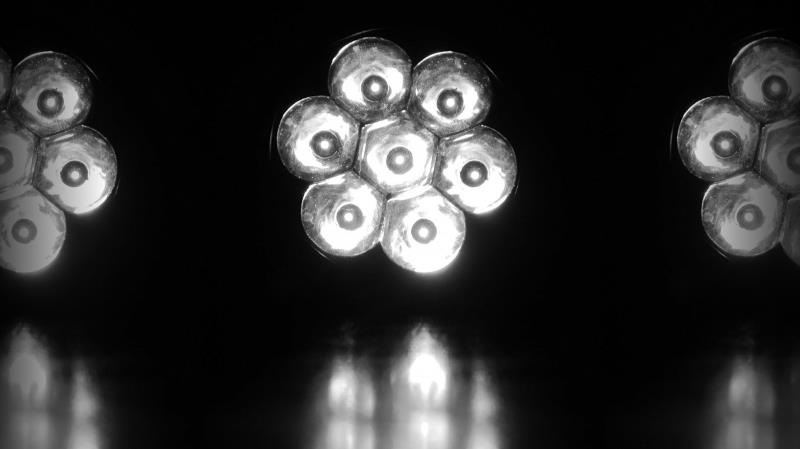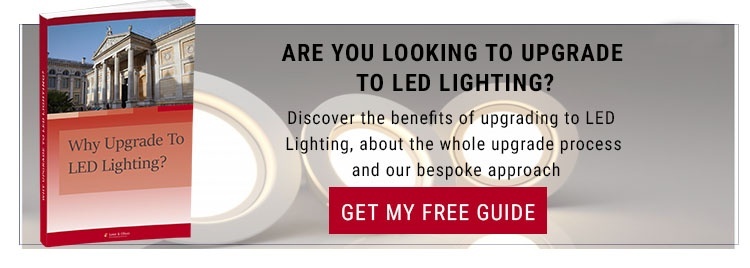
Upgrading an ageing and inefficient lighting infrastructure to a modern LED-based design is a large undertaking, especially in an extensive or complex building. When dealing with historic buildings in particular, there may be extensive electrical work required before the lighting upgrade can even take place, such as replacing antiquated wiring, or making special design considerations to preserve the character of the building. This comes with a price tag that can be quite high, so how do you justify an LED lighting upgrade in an organisation where budgets are tight?
Financial Benefits
Fortunately, once installed, energy-efficient LED lighting quickly begins to recoup its costs. The low operating cost and long life of LED lights are the biggest financial benefits of undertaking an upgrade. To give a picture of the savings, a complete upgrade to LED lighting from older fluorescent or incandescent bulbs can give tangible energy savings of 50% to 80% each year – a huge figure in a large building.
This allows organisations to achieve a positive ROI within a reasonable time, certainly when viewed over the life-cycle of an LED lighting design. This negates all costs over time, especially when combined with public funding programmes and grants, which are available to help organisations meet the upfront costs of LED lighting upgrades.
Design Benefits
LED lighting also opens up exciting possibilities for creative use of lighting that simply weren’t possible before. The quality of LED light is sharper and more attuned to natural daylight, giving a more positive and enjoyable user experience. The bulbs themselves are also less obtrusive and require less supporting infrastructure, making it possible to provide more light in certain areas, or to adapt lighting to the specific needs of displays and functions in particular rooms.
Monetary savings and flexibility aside, the following are the main benefits of upgrading to LED lighting. As every case is different, there may even be some more unique benefits in your case, so please get in touch to discuss your requirements.
1) Reduced Energy Use
LED lights use substantially less electricity than incandescent or fluorescent bulbs. A typical LED bulb uses only 5 W of energy; 10 times less than the average 50 W used by a standard halogen bulb. No wonder that organisations normally notice an immediate financial benefit in the wake of an upgrade to LED lighting.
2) Better Use Of Light
LED lights are not only more efficient in their energy use, but also in the way they apply and disperse light. In a standard light bulb with a diffusion angle of 270°, much of the light is wasted – in other words energy is spent to no good use. Not so with LED lights. When using LED downlights, the more restricted angle of around 130° means that the light is better directed and less is wasted.
3) Versatility
Lighting design is all about directing light to particular areas at particular times. This is difficult with standard light bulbs, and is why designers historically had to use a complex network of diffusers and reflectors to trap and redirect light. LED lights have the benefit of being able to emit light in a specific direction, reducing the need for supporting infrastructure. This actually makes LED lighting design cheaper than traditional lighting. LED lights can be adapted as ceiling downlights, architectural lighting, emergency lighting and more.
4) Reduced Heat Waste
A substantial amount of the energy poured into incandescent and fluorescent bulbs ends up being wasted as heat. This is why offices, art galleries and hospital departments – among other buildings – tend to get so hot. An incandescent bulb operates by heating a metal filament until it glows, while fluorescent bulbs superheat a gas filled chamber until it glows. In both cases light is technically the waste product, not the primary emission. In some older models of light bulb, up to 90% of the energy produced is heat rather than light. This is hugely wasteful and is also a fire risk. LEDs produce far less heat due to the use of tiny diodes to generate light. The small amount of waste heat that is produced is normally absorbed backwards into a heat sink integral to the light bulb, so that LED light arrays remain safe and cool to the touch.
5) Eco-Friendly
LED lights consume less resources and are far more environmentally friendly to produce than other types of bulb. They contain less metal, little or no glass and use no toxic substances – such as the mercury used in the coils of fluorescent bulbs. This makes LED bulbs cheaper to make and easier to recycle.
6) Longer Working Life
Each LED bulb gives longer hours of operation than the equivalent traditional light bulb. The differences are substantial. An incandescent bulb may need to be replaced every three months when subjected to heavy use – approximately 1000 hours before it burns out. Compared to this an LED bulb might serve for 50,000 hours of use; around 10 years before it needs replacing. This massively out competes the 6000 working hours of the average compact fluorescent bulb, the nearest competitor in the efficient lighting stakes.
Discover More Benefits Of LED Lighting
As we have touched on in this article, the benefits of upgrading to LED lighting are diverse and far-reaching. It makes good financial sense to upgrade to LED lighting, but it also makes it easier to meet legal lighting requirements and expands the ways in which your lighting architecture can enhance the experience of your building users.
To discuss your unique requirements with one of our team, please get in touch today by calling 01865 322200 (Oxford) or 02380 614700 (Southampton). More free information about LED lighting can also be found in our new e-book: Why Upgrade to LED Lighting? You can download a complimentary copy today by clicking here.



